The Premature Mortality of Sabinos or Montezuma Bald Cypress (Taxodium mucronatum Ten.) in the State of Durango, Mexico
Abstract
1. Introduction
- The location of the trees and the geomorphology of the sites allows for the stabilization of the sediments that compose the streambanks, thus preventing excessive soil erosion [13].
- They present pleasant microclimates, where the high humidity and lower temperature than the surrounding areas allow for a great diversity of species, thus tolerating the development of local fauna, both terrestrial and aquatic, and supporting the dispersion of species because the forests are used as natural wildlife corridors [14].
- Due to their biodiversity, they present great ecological dynamism that supports the closing of the biogeochemical cycles of water, carbon, and nitrogen, among others [5].
- They provide food and consumption materials, among other resources.
2. Materials and Methods
2.1. Characteristics of the Gallery Forests of the Tunal, Durango, and Poanas Rivers
2.2. Resistance of Sabinos to Water Quality
2.2.1. Collection of Sabino Seedlings and Their Adaptation in a Greenhouse
2.2.2. Seedling Survival Evaluation
2.2.3. Types of Water Quality
2.2.4. Experimental Design
2.2.5. Removal Efficiencies Achieved by the Presence of Seedlings
3. Information Analyses
3.1. Water Quality
3.2. Data Analysis
4. Results
4.1. Vegetation Cover
4.2. Water Quality
4.2.1. Differences Among the Effluents Used to Assess the Survival of Seedlings
4.2.2. pH Values
4.2.3. Electrical Conductivity (EC)
4.2.4. Content of NH4+/NH3
4.2.5. Total Solids (TS)
4.2.6. Total Volatile Solids (TVS)
4.2.7. Fecal Coliforms (FC)
4.2.8. Water Characteristics After 7 Days with the Seedlings
4.2.9. Tolerance of Sabino Seedlings and Differences in Growth and Presence of New Leaves in Sabinos
- In the first experiment, the water from the E-WTP, both influent and effluent, did not cause deaths. Growth occurred, and new shoots were registered in 14 of the seedlings. It should be remembered that the seedlings spent 21 days under these types of water, which are the most common and have greater volumes in the area. For decades, the wastewater from the urban area was poured into the channel that leads to the gallery forests. Since the year 2000, it has been distributed among the farmers.
- In the second experiment, it was observed that growth occurred with the water from the San Carlos Bridge (SCB). This water comes mainly from the industrial zone of the City of Durango, sometimes receiving some water from the E-WTP; growth was observed in the individuals that received it. When BP water was added, they did not die but neither did they have outbreaks. With the water from the cheese factory, although they did not die after 7 days, four individuals died 6 days after the water was withdrawn. Furthermore, in the pots with the same water and gravel, a light white layer was formed on the gravel surface, presumably made up of salts, that did not appear in any of the other pots of the other groups. This indicates that the sabinos do not tolerate the quality of water from the Holland Cheese Factory.
5. Discussion
5.1. Riparian Quality
5.2. Seedling Survival
6. Conclusions
Supplementary Materials
Author Contributions
Funding
Institutional Review Board Statement
Informed Consent Statement
Data Availability Statement
Acknowledgments
Conflicts of Interest
References
- Milo, A. The history of the ahuehuete, the iconic Mexican national tree of ‘La Noche Triste’. Natl. Geogr. Español 2022. [Google Scholar]
- Sarmiento, M. Ahuehuetes, the Old Men of the Water. 2022. Available online: https://www.mexicodesconocido.com.mx/ahuehuetes-los-viejos-del-agua.html (accessed on 1 February 2024).
- Díaz, J.V.; Stahle, D.W.; Paredes, J.C.; Ávalos, J.E.; García, V.C. Hydrological response of Sabino (Taxodium mucronatum Ten.) in gallery forests of the San Pedro Mezquital River, Durango. Rev. Mex. Cienc. For. 2013, 4, 9–19. [Google Scholar]
- Rzedowski, J. Vegetación de México; Editorial Limusa S.A.: Mexico City, Mexico, 2006. [Google Scholar]
- Peña, E.G.E.; Azpiri, H.S.; Barrera, G.M. Viability and germination of Taxodium mucronatum (Ten.) seeds in the state of Querétaro, Mexico. Agrociencia 2004, 38, 375–381. [Google Scholar]
- Cortés-Arroyo, A.R.; Domínguez-Ramírez, A.M.; Gómez-Hernández, M.; López, J.R.M.; Hurtado, M.; de la Peña, M.H.Y.; Ló-pez-Muñoz, F.J. Antispasmodic and bronchodilator activities of Taxodium mucronatum Ten. leaf extract. Afr. J. Biotechnol. 2011, 10, 54–64. [Google Scholar]
- Luján-Hidalgo, M.C.; Gutiérrez-Miceli, F.A.; Ventura-Canseco, L.M.C.; Dendooven, L.; Mendoza-López, M.R.; Cruz-Sánchez, S.; García-Barradas, O.; Abud-Archila, M. Chemical composition and antimicrobial activity of Bursera graveolens and Taxodium mucronatum essential oils from Chiapas, México. Gayana Bot. 2012, 69, 7–14. [Google Scholar]
- Correa-Díaz, A.; Gómez-Guerrero, A.; Villanueva-Díaz, J.; Castruita-Esparza, L.U.; Martínez-Trinidad, T.; Cervantes-Martínez, R. Dendroclimatic analysis of ahuehuete (Taxodium mucronatum Ten.) in Central Mexico. Agrociencia 2014, 48, 537–551. [Google Scholar]
- Nahuelhual, L.; Donoso, P.; Lara, A.; Nuñez, D.; Oyarzun, C.; Neira, E. Valuing ecosystem services of chilean temperate rainforests. Environ. Dev. Sustain. 2007, 9, 481–499. [Google Scholar] [CrossRef]
- Suzán-Azpiri, H.; Enríquez-Peña, G.; Malda-Barrera, G. Population structure of the Mexican baldcypress (Taxodium mucronatum Ten.) in Queretaro, Mexico. For. Ecol. Manag. 2007, 242, 243–249. [Google Scholar] [CrossRef]
- Villanueva-Díaz, J.; Stahle, D.W.; Therrell, M.D.; Beramendi-Orosco, L.; Estrada-Ávalos, J.; Martínez-Sifuentes, A.R.; Astudillo-Sánchez, C.C.; Cervantes-Martínez, R.; Cerano-Paredes, J. The climatic response of baldcypress (Taxodium mucronatum Ten.) in San Luis Potosi, Mexico. Trees 2020, 34, 623–635. [Google Scholar] [CrossRef]
- Martínez-Sifuentes, A.R.; Villanueva-Díaz, J.; Crisantos-De La Rosa, E.; Stahle, D. Current and future modeling of the habitat suitability of the ahuehuete (Ten.): A proposal for conservation in Mexico. Bot. Sci. 2021, 99, 752–770. [Google Scholar] [CrossRef]
- Patten, D.T. Riparian ecosytems of semi-arid North America: Diversity and human impacts. Wetlands 1998, 18, 498–512. [Google Scholar] [CrossRef]
- WWF. The San Pedro Mezquital River, the Great Unknown. 2012. Available online: https://wwflac.awsassets.panda.org/downloads/san_pedro_mezquital_2012.pdf (accessed on 1 December 2023).
- Villanueva, J.; Cerano, J.; Stahle, D.; Constante, V.; Vázquez, l.; Estrada, J.; Benavides, J. Long-lived trees of Mexico. Rev. Mex. Cienc. For. 2010, 1, 95–145. [Google Scholar]
- WWF. The San Pedro Mezquital River Basin. Technical Data. 2024. Available online: https://wwflac.awsassets.panda.org/downloads/fichatecnica_sanpedromezquital.pdf (accessed on 1 January 2024).
- Lifeder. Ahuehuete. 2022. Available online: https://www.lifeder.com/ciclo-vida-ahuehuete/ (accessed on 26 June 2024).
- WWF. DECREE Abrogating the Agreements Indicated and Establishing the Water Reserve in the Hydrological Basins Indicated. 2024. Available online: https://www.wwf.org.mx/que_hacemos/programas/programa_agua/san_pedro_mezquital/spm_la_cuenca/cuencas_altas_y_media/ (accessed on 1 February 2024).
- Hydrological Information System (SIH). 2019. Available online: http://hpiph.org/Hydrology%20Project-II/hisc.htm (accessed on 26 June 2024).
- Pérez-López, M.E.; Almonte-G, O.A.; Vicencio-de la Rosa, M.G.; Valencia-Vazquez, R.; Martínez-Prado, M.A.; Teutli-León, M.M.M. Evaluation of domestic wastewater treatment plants in the municipality of Durango. In Proceedings of the XIII Congreso Internacional y XIX Congreso Nacional de Ciencias Ambientales, Acapulco, Mexico, 11–13 June 2014; ISBN 978-607-9232-19-21. [Google Scholar]
- García, R.G. Evaluation of water quality changes for aquatic life in El Saltito, Nombre de Dios, Durango. Instituto Politécnico Nacional (National Polytechnic Institute Interdisciplinary Research Center for Regional Integral Development Durango Unit), Durango Dgo. 2011. Available online: http://www.repositoriodigital.ipn.mx/handle/123456789/12684 (accessed on 1 May 2024).
- CAED. Coverage and Efficiency Rates of Potable Water, Sewage and Sanitation in the State of Durango; CAED: Durango, Mexico, 2020; pp. 15–35. [Google Scholar]
- Pérez-López, M.E.; González, M.S.; Lopez-Gonzalez, C.; Martínez-Prado, A.; Cuevas-Rodríguez, G. Aquatic macrophytes tolerance to domestic wastewater and their efficiency in artificial wetlands under greenhouse conditions. Hidrobiológica 2009, 19, 233–244. [Google Scholar]
- NMX-AA-034-SCFI-2015; Análisis de Agua-Medición de Sólidos y Sales Disueltas en Aguas Naturales, Residuales y Residuales Tratadas-Método de Prueba. 2015. Available online: https://www.gob.mx/cms/uploads/attachment/file/166146/nmx-aa-034-scfi-2015.pdf (accessed on 1 February 2023).
- NMX-AA-042-SCFI-2015; Determinación del Número Más Probable (NMP) de Coliformes Totales, Coliformes Fecales (Termotolerantes) y Escherichia Coli. 2015. Available online: https://www.gob.mx/cms/uploads/attachment/file/166147/nmx-aa-042-scfi-2015.pdf (accessed on 1 February 2023).
- Statistica 7.0; 2004. TIBCO Software Inc. Available online: https://statistica.software.informer.com/7.0/ (accessed on 1 May 2024).
- NOM-001-SEMARNAT-2021; Establece los Límites Máximos Permisibles de Contaminantes en las Descargas de Aguas Residuales en Aguas y Bienes Nacionales. 2022. Available online: https://www.dof.gob.mx/nota_detalle.php?codigo=5645374&fecha=11/03/2022#gsc.tab=0 (accessed on 1 February 2023).
- Aviña-Jiménez, F.A. Evaluation of the Distribution of the Crayfish Procambarus Clarkii in the Upper San Pedro River Basin, as a Basis for Establishing a Management Strategy; Instituto Politécnico Nacional (National Polytechnic Institute Interdisciplinary Research Center for Regional Integral Development Durango Unit): Durango, Mexico, 2024. [Google Scholar]
- Rodríguez-Téllez, E.; Domínguez-Calleros, P.A.; Pompa-García, M.; Quiroz-Arratia, J.A.; Pérez-López, M.E. Quality of the riparian forest of the El Tunal river, Durango, Mexico, using the QBR index. Gayana Botánica 2012, 69, 147–151. [Google Scholar] [CrossRef]
- NOM-001-SEMARNAT-2021; Establishes the Permissible Limits of Pollutants in Wastewater Discharges into Receiving Bodies Owned by the Nation. Secretaría de Medio Ambiente y Recursos Naturales: Mexico City, Mexico, 2022; p. 16.
- James, D.W.; Hank, R.J.; Jurinak, J.J. Modern Irrigated Soils; John Wiley and Sons: Hoboken, NJ, USA, 1982. [Google Scholar] [CrossRef]
- Villanueva-Díaz, J.; Cerano-Paredes, J.; Constante-García, V.; Stahle, D.W.; Martínez Sifuentes, A.; Durán Guerra, O. Dynamics of Sabino (Taxodium mucronatum Ten.) Populations in the San Pedro Mezquital River, 1st ed.; INIFAP: Gomez Palacio, Mexico, 2013; Volume 1a, p. 36. [Google Scholar]
- Rodriguez-Tellez, E.; Garcia-de-Jalon, D.; Perez-Lopez, M.E.; Torres-Herrera, S.I.; Ortiz-Carrasco, R.; Pompa-Garcia, M.; Morales-Montes, M.; García-García, D.A.; Zamudio-Castillo, E. Characterization of the ecological quality of the gallery forest of the river La Sauceda, Durango, Mexico. Hidrobiológica 2016, 26, 27–32. [Google Scholar] [CrossRef]
- DOF.2012.NMX-AA-159-SCFI-2012; That Establishes the Procedure for Environmental Flow Determination in Hydrological Basin. 2012. Available online: https://www.gob.mx/cms/uploads/attachment/file/166834/NMX-AA-159-SCFI-2012.pdf (accessed on 1 June 2024).
- DOF. DECREE Abrogating the Agreements Indicated and Establishing the Water Reserve in the Hydrological Basins Indicated. 2014. Available online: https://dof.gob.mx/nota_detalle.php?codigo=5360310&fecha=15/09/2014#gsc.tab=0 (accessed on 26 June 2024).
- Perez-López, M.E.; Aguilar-Avalos, M.C. Integrated Water Management Plan for the San Quintín Ravine in Durango, Dgo. Mexico to Restore and Maintain Its Ecosystem Services; Science and Technology Council of the State of Durango (COCYTED): Durango, Mexico, 2024. [Google Scholar]
- Pineda-López, R.; Barba-Macias, E.; Martinez-Rivera, L.M.; Moreno-Casasola, P.; Pérez-López, M.E. Ecohydrology for Sustainability and Governance of Water and Watersheds for the Common Good; National Council of Sciences, Humanities and Technology (Conahcyt): Mexico City, Mexico, 2024.
- López, M.E.P.; Sanchez-Martinez, M.G.; de la Rosa, M.G.V.; Leon, M.T. Eutrophication levels through San Pedro Mezquital river basin. J. Environ. Prot. 2013, 4, 45–50. [Google Scholar] [CrossRef]
- Oluwaseun-Akinnawo, S. Eutrophication: Causes, consequences, physical, chemical and biological techniques for mitigation strategies. Environ. Chall. 2023, 12, 100733. [Google Scholar] [CrossRef]
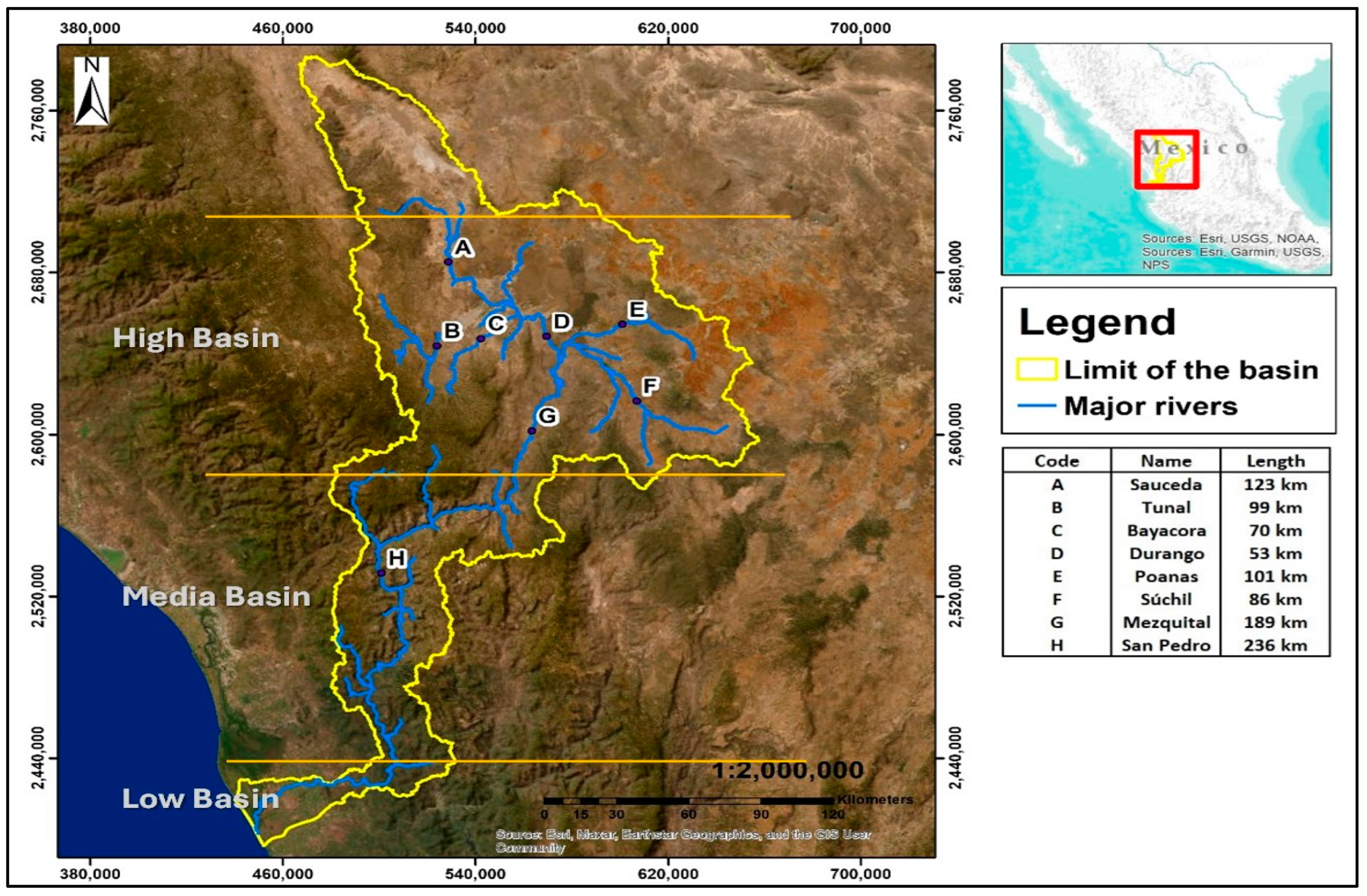
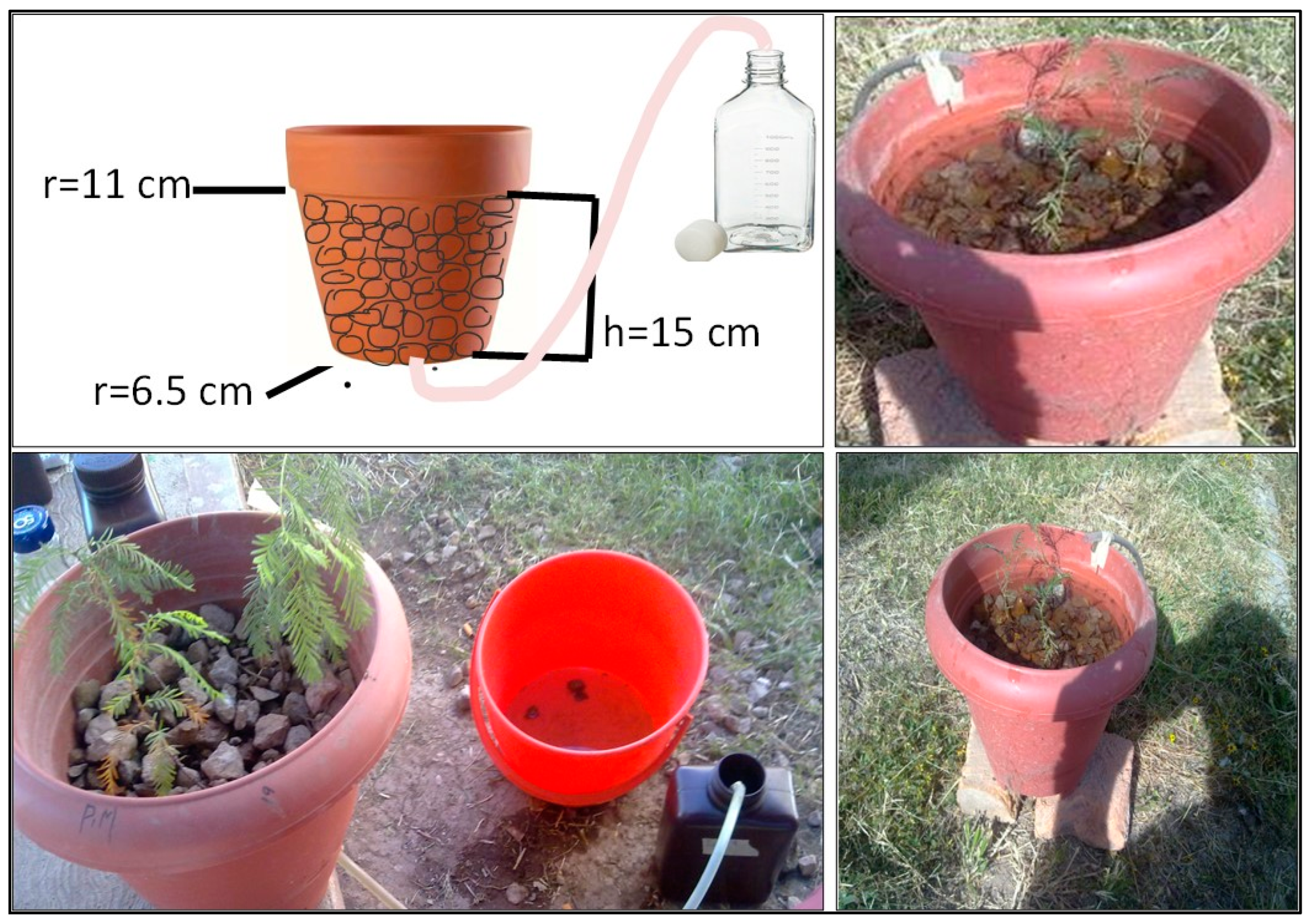
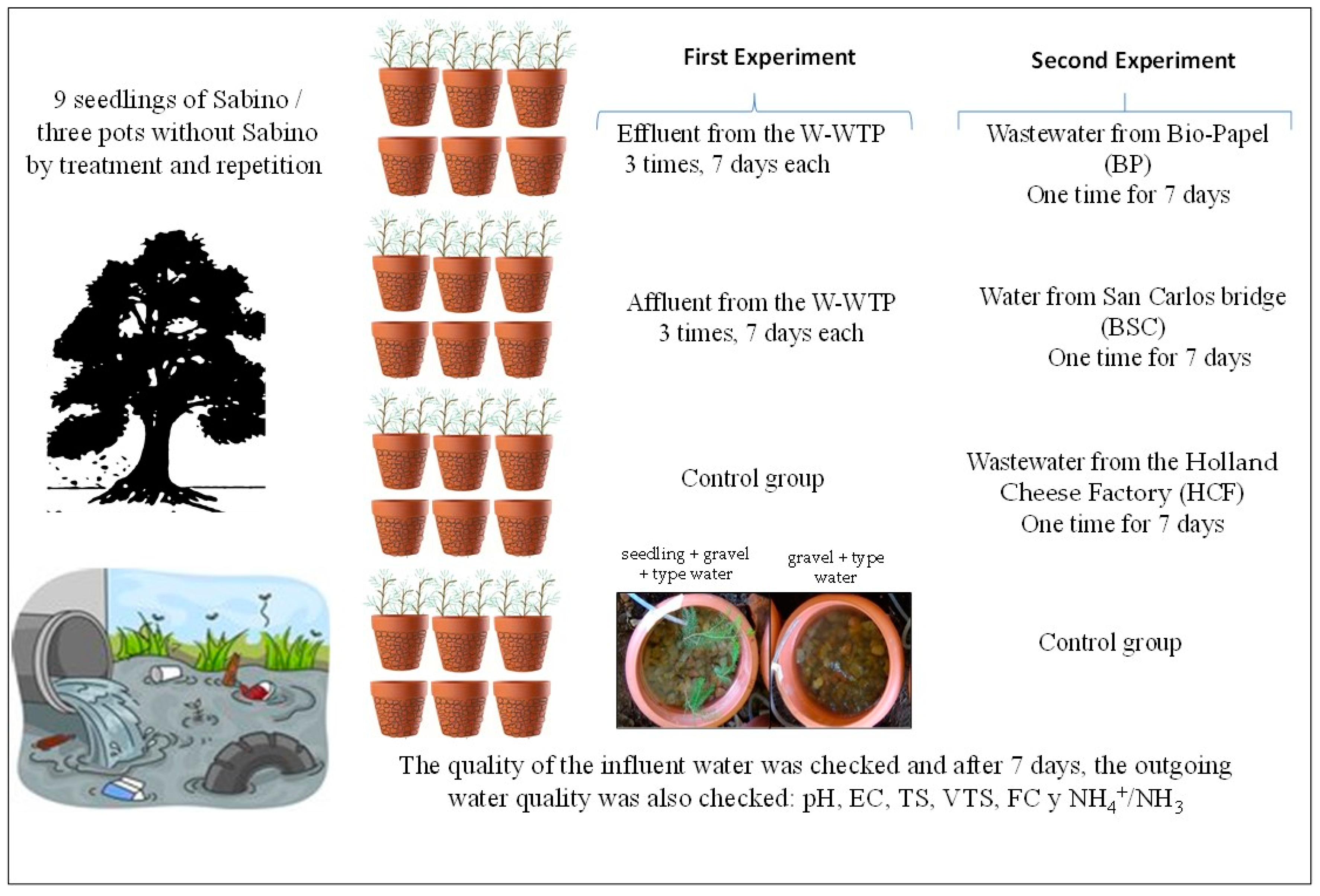
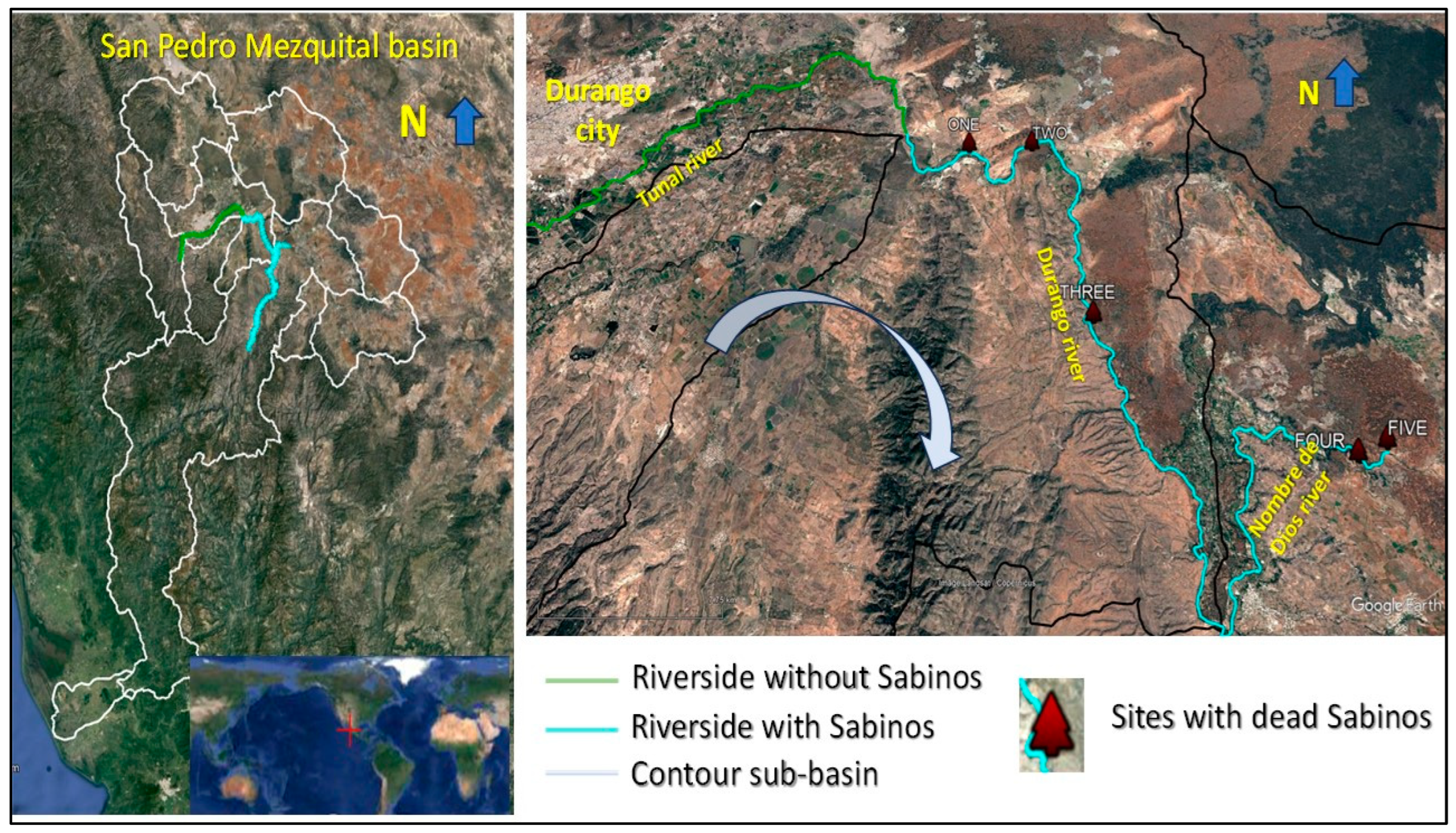
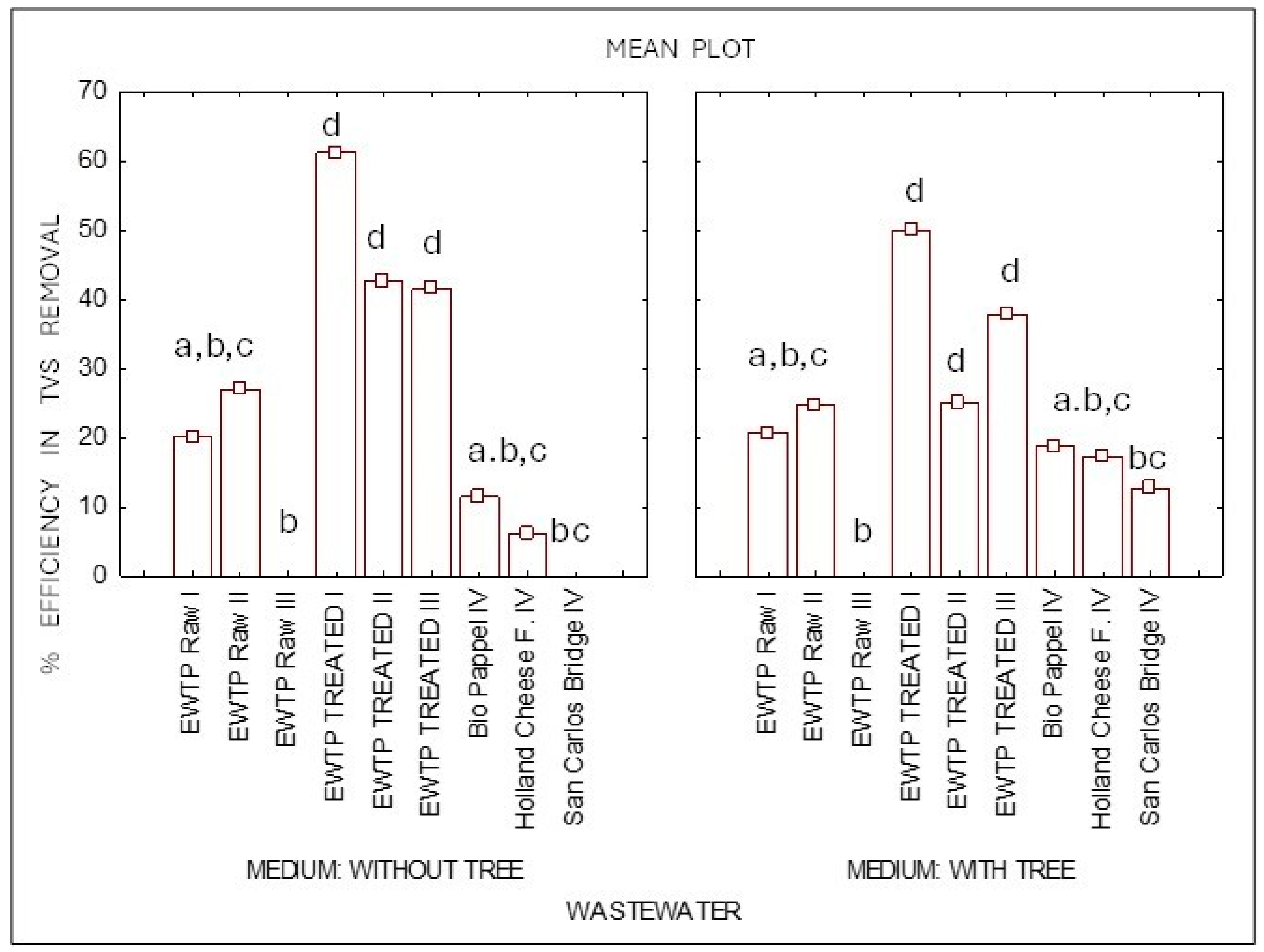
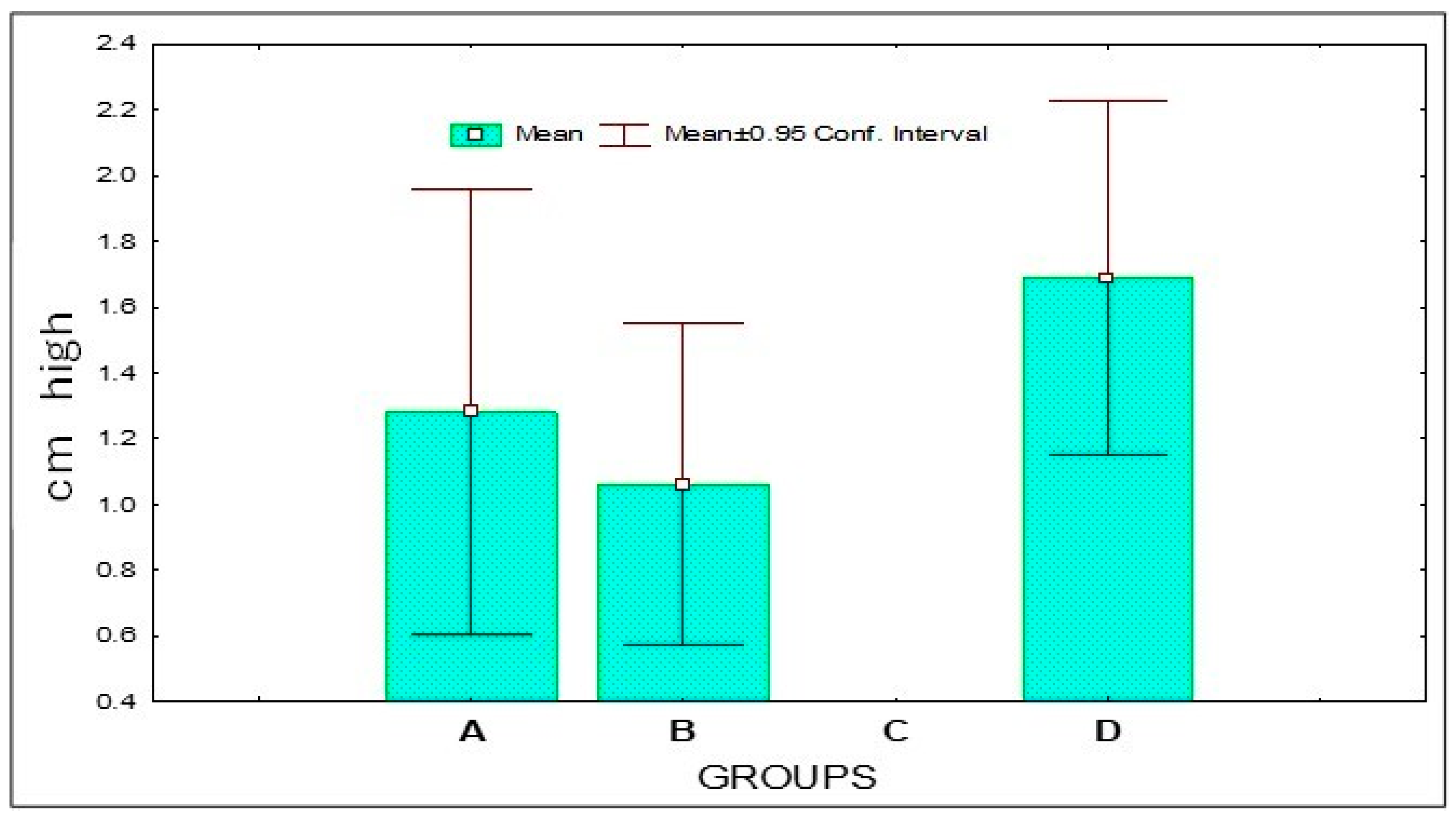
| Site | Coordinates | AMSL * | Damage in Ha | Possible Cause | Year It Dried Up | Fuente |
|---|---|---|---|---|---|---|
| 1 | 24°02′01″ N 104°23′31″ W | 1859 | 3.1 | Change in the river’s course due to anthropogenic use | Before 2002 | Image analysis and visits to sites |
| 2 | 24°2′32.41″ N 104°21′29.92″ W | 1856 | 1 | Dry spring and zero flow | 2011 | Image analysis and visits to selected sites, CNA’s hydrometric data |
| 3 | 23°56′50.39″ N 104°19′1.92″ W | 1813 | 0.21 | Zero flow, use of wastewater in irrigation | 2000 and today | CNA’s hydrometric data |
| 4 | 23°54′32″ N 104°10′51″ W | 1830 | 4 | Dry spring and zero flow | 2014 | Image analysis and visits to selected sites |
| 5 | 23°54′0.09″ N 104°11′50″ W | 1830 | 0.26 | Dry spring | 1970 | Image analysis and visits to selected sites |
| Sample | pH | EC | TS | TVS | NH4+/NH3 | log FCU/100 mL Water |
|---|---|---|---|---|---|---|
| (µS/cm) | mg/L | |||||
| NOM-001-SEMARNAT-2021 | 6–9 | N. C. | N. C. | N. C. | N. C. | 2.77 |
| IEWTP Raw I | 7.38 c | 748 f | 686 e | 283 f | 25 | 4.75 |
| IEWTP Raw II | 7.57 d | 647 d | 732 f | 203 e | 33 | 4.34 |
| IEWTP Raw III | 8.22 f | 762 h | 619 d | 269 f | 31 | 4.87 |
| EEWTP Treated I | 7.58 d | 718 c | 510 c | 156 cd | 22 | 2.69 |
| EEWTP Treated II | 7.26 b | 731 b | 485 c | 180 ce | 32 | 0.9 |
| EEWTP Treated III | 8.25 f | 759 g | 478 b | 149 b | 28 | 2.47 |
| BP IV | 8.50 g | 1835 i | 1542 g | 360 g | −3 | |
| HCF IV | 5.60 a | 3380 j | 3302 h | 1427 h | 4.61 | |
| SCB IV | 7.57 d | 746 e | 511 c | 175 ce | 3.14 | |
| Control | 7.80 e | 467 a | 378 a | 116 a | 0 | |
| AVERAGE | 8 | 1147 | 979 | 365 | 29 | 4.33 |
| Maximum | 8.4 | 3381 | 3302 | 1427 | 33 | 4.87 |
| Minimum | 5.6 | 646 | 378 | 117 | 22 | 0 |
| ANOVA results | F = 2770 | F = 810,445 | F = 1555 | F = 187.5 | F = 2342 | |
| p < 0.001 | p < 0.001 | p < 0.001 | p < 0.001 | p < 0.001 | ||
Disclaimer/Publisher’s Note: The statements, opinions and data contained in all publications are solely those of the individual author(s) and contributor(s) and not of MDPI and/or the editor(s). MDPI and/or the editor(s) disclaim responsibility for any injury to people or property resulting from any ideas, methods, instructions or products referred to in the content. |
© 2024 by the authors. Licensee MDPI, Basel, Switzerland. This article is an open access article distributed under the terms and conditions of the Creative Commons Attribution (CC BY) license (https://creativecommons.org/licenses/by/4.0/).
Share and Cite
Perez-Lopez, M.E.; Leal-Saenz, A.; Ortiz-Olivas, M.E.; Ramirez-Crescencio, F.; Arreola-Ortiz, A.E. The Premature Mortality of Sabinos or Montezuma Bald Cypress (Taxodium mucronatum Ten.) in the State of Durango, Mexico. Sustainability 2024, 16, 10248. https://doi.org/10.3390/su162310248
Perez-Lopez ME, Leal-Saenz A, Ortiz-Olivas ME, Ramirez-Crescencio F, Arreola-Ortiz AE. The Premature Mortality of Sabinos or Montezuma Bald Cypress (Taxodium mucronatum Ten.) in the State of Durango, Mexico. Sustainability. 2024; 16(23):10248. https://doi.org/10.3390/su162310248
Chicago/Turabian StylePerez-Lopez, Maria Elena, Alejandro Leal-Saenz, Maria Elena Ortiz-Olivas, Fermin Ramirez-Crescencio, and Ariana Elizabeth Arreola-Ortiz. 2024. "The Premature Mortality of Sabinos or Montezuma Bald Cypress (Taxodium mucronatum Ten.) in the State of Durango, Mexico" Sustainability 16, no. 23: 10248. https://doi.org/10.3390/su162310248
APA StylePerez-Lopez, M. E., Leal-Saenz, A., Ortiz-Olivas, M. E., Ramirez-Crescencio, F., & Arreola-Ortiz, A. E. (2024). The Premature Mortality of Sabinos or Montezuma Bald Cypress (Taxodium mucronatum Ten.) in the State of Durango, Mexico. Sustainability, 16(23), 10248. https://doi.org/10.3390/su162310248






